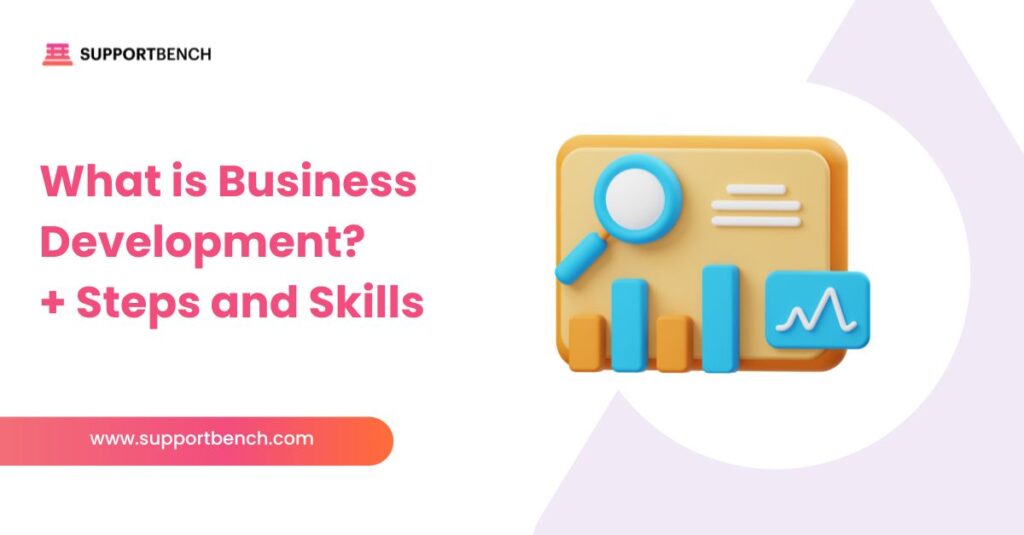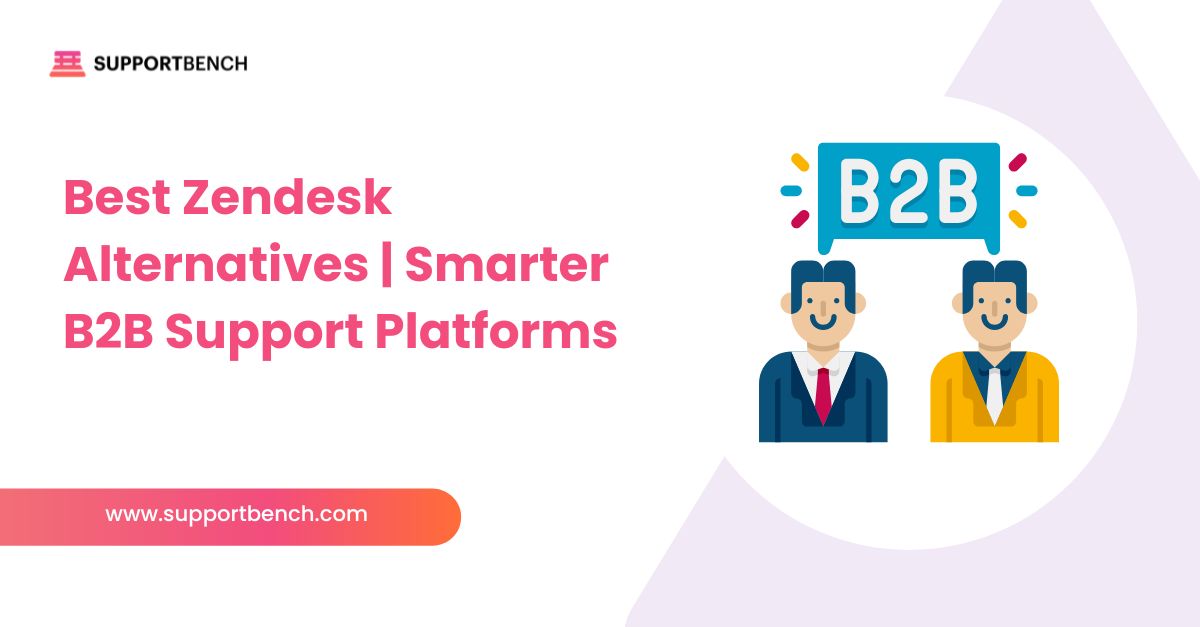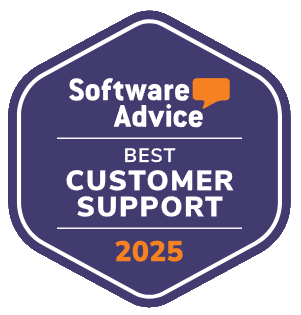Business development is a key driver of long-term growth and competitive advantage. It involves identifying opportunities, expanding into new markets, and building relationships that bring value across the organization.
It connects strategy with action. Business development isn’t limited to one department—it supports sales, marketing, operations, and leadership by aligning efforts toward common goals.
Whether you’re entering a new market, improving client engagement, or exploring new partnerships, business development helps turn opportunity into sustained success.
To support these efforts, tools like CRMs and analytics platforms are essential. Platforms such as Supportbench help teams manage relationships, uncover insight-driven opportunities, and make more informed growth decisions.
At a Glance:
Business development is the strategic process of creating long-term value through market research, lead generation, and partnerships. It differs from sales by focusing on opportunity creation, not immediate revenue. To succeed, you need communication skills, strategic thinking, and data-driven tools like CRMs.
What is Business Development?

Business development is the process of identifying and creating opportunities that drive long-term value for a company. This might involve entering new markets, improving customer relationships, launching partnerships, or refining internal processes to unlock growth.
It’s not a single task—it’s a blend of research, planning, outreach, and strategic thinking. At its core, business development is about helping the organization grow in sustainable, strategic ways.
The scope varies by company. In some businesses, it’s tied closely to sales. In others, it includes product development, partnerships, or even funding and mergers. What remains consistent is the goal: building a stronger, more competitive business over time.
How does business development differ from sales?
Business development and sales often work side by side, but they’re not the same.
Sales focuses on converting qualified leads into paying customers. Business development focuses on identifying those opportunities in the first place—through research, partnerships, or market expansion.
Here’s a quick breakdown:
Key Differences Between Business Development and Sales | ||
| Aspect | Business Development | Sales |
| Main Focus | Long-Term Growth Opportunities | Revenue Generation |
| Objective | Create Strategic Value | Convert Leads Into Deals |
| Approach | Research, Plan, Build Relationships | Pitch, Negotiate, Close |
| Timeline | Long-Term and Strategic | Short- to Mid-Term |
| Key Activities | Market Analysis, Partnerships, Lead Qualification | Prospecting, Demos, Closing |
| Metrics | Pipeline Growth, Market Reach, Partner Value | Revenue, Conversion Rates, Sales Targets |
| Tool Use | CRMs, Analytics Platforms, Industry Reports | CRMs, Email Tools, Proposal Platforms |
Collaboration, Not Competition
The two functions are complementary. Business development creates the conditions where sales can succeed. It identifies high-potential markets, nurtures early relationships, and brings in qualified opportunities.
Sales then takes those opportunities across the finish line. Both teams rely on tools like CRM platforms and shared performance metrics—but they work toward different stages of the growth journey.
In short, business development opens the door. Sales helps you walk through it.
Potential Areas for Business Development
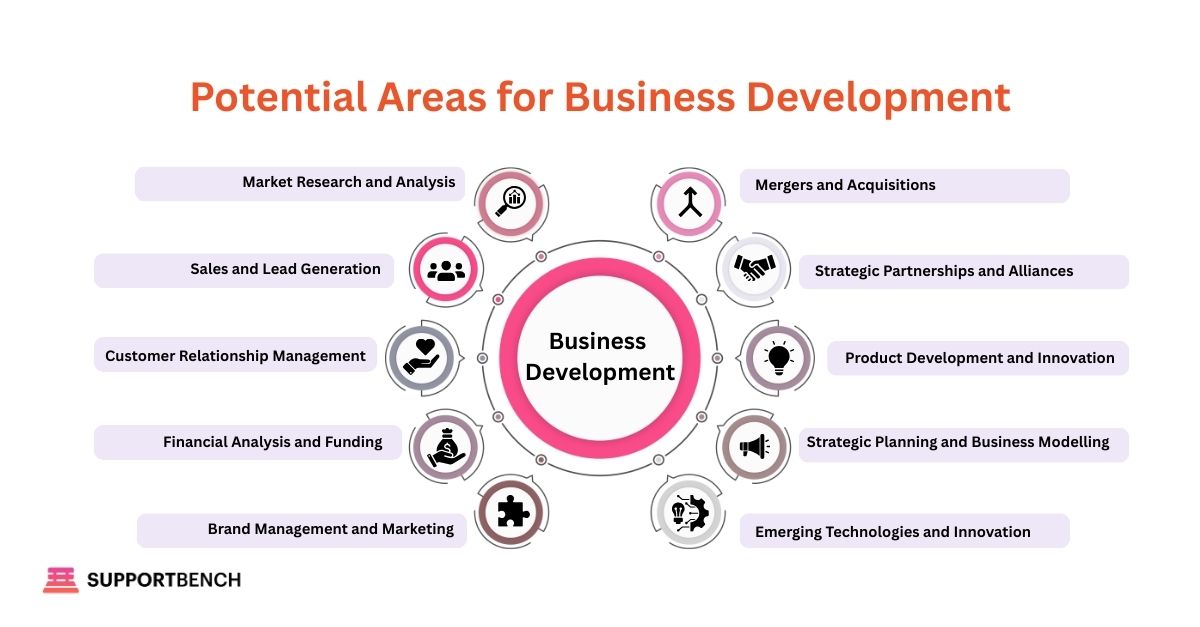
Business development touches nearly every function in an organization. It requires cross-team collaboration, strategic thinking, and clear planning. Here are some of the most common areas where business development plays a role:
Market Research and Analysis
Explore new opportunities by studying market trends, customer needs, and competitor gaps. This step helps shape strategy and avoid wasted effort.
Sales and Lead Generation
Work closely with the sales team to identify and qualify leads. Business development often focuses on finding fit and potential—so sales can focus on conversion.
Strategic Partnerships and Alliances
Build strong alliances and joint ventures that offer mutual benefits—such as co-marketing, expanded distribution, or resource sharing.
Effective strategic partnership development can open new markets and strengthen competitive positioning when aligned with long-term growth goals.
Product Development and Innovation
Use customer feedback and market studies to guide product direction. Business development helps identify gaps and new opportunities for innovation.
Customer Relationship Management
Develop initiatives that retain customers, improve satisfaction, and increase lifetime value. This includes leveraging CRM tools and feedback loops.
Strategic Planning and Business Modeling
Map out growth goals, test new models, and create realistic plans for scaling operations and revenue.
Mergers and Acquisitions
Identify strategic fit, conduct due diligence, and support deal negotiation. This is especially relevant in fast-scaling industries.
Brand Management and Marketing
Help shape positioning, messaging, and multi-channel outreach. Strong alignment between marketing and BD ensures clear value communication.
Financial Analysis and Funding
Research grants, investor opportunities, and capital planning to support growth strategies.
Emerging Technologies and Innovation
Assess how new technologies impact your industry—and use those insights to drive smarter business decisions.
Each of these areas requires collaboration, planning, and long-term thinking. To turn them into a clear path for growth, companies need a structured strategy. That’s where a step-by-step business development plan comes in.
Steps to Create a Business Development Strategy
A business development strategy turns growth goals into clear, actionable steps. Each stage has a defined purpose, involves specific teams, and leads to measurable outcomes. Here’s how to build one:
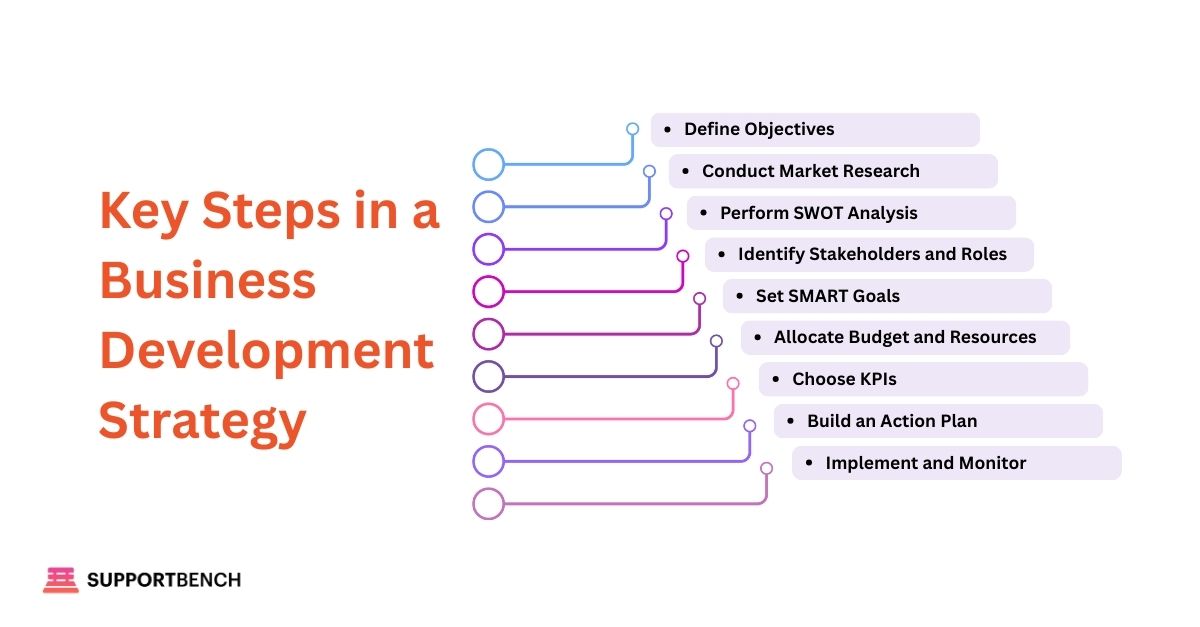
Define Objectives
Start by setting precise objectives. Leadership and business development managers decide if the priority is market entry, client retention, diversification, or revenue growth.
Outcome: Objectives give all teams a shared definition of success and ensure resources target the most valuable opportunities.
Conduct Market Research
Research teams, product managers, and customer success staff gather data on customer demand, competitor activity, and industry trends. They also define the ideal customer profile and segment audiences.
Outcome: A clear view of where growth is possible and how to position the business.
Perform SWOT Analysis
Cross-functional groups review strengths, weaknesses, opportunities, and threats. Internal factors include brand reputation and resources; external risks include competitive pressure and regulation.
Outcome: A balanced view that links organizational capability to real market conditions.
Identify Stakeholders and Roles
Clarify responsibilities early. Marketing drives awareness, sales qualify leads, while executives focus on partnerships and negotiations.
Outcome: Defined roles prevent duplication, establish accountability, and ensure smooth coordination across departments.
Set SMART Goals
Translate broad objectives into specific, measurable, attainable, relevant, and time-bound goals. For example: securing five new enterprise clients in one quarter.
Outcome: Measurable benchmarks provide accountability and clear progress tracking.
Allocate Budget and Resources
Finance and leadership allocate funds across staffing, technology, marketing, and partnerships. This includes sales enablement, training, and system investments.
Outcome: A realistic allocation that makes initiatives both achievable and sustainable.
Choose KPIs
Business development, sales, and customer success teams align on metrics like qualified leads, partnership value, client retention, or revenue from new markets.
Outcome: KPIs make performance visible. Platforms like Supportbench centralize these indicators, so teams can track whether activities deliver the expected results.
Build an Action Plan
Business development reps and marketing coordinators assign tasks and set timelines. Activities might include a weekly quota of outreach calls or a set number of partnership proposals.
Outcome: Structured daily execution that keeps progress deliberate and aligned with strategy.
Implement and Monitor
Roll out the plan and review KPIs regularly. Adjust strategies when results fall short. CRMs and analytics tools, such as Supportbench, consolidate customer history, engagement, and reporting into a single system.
Outcome: A strategy that remains flexible, accountable, and consistently effective.
You Might Also Like:
The Business Development Process in Practice
Once your strategy is defined, the next step is execution. A business development process takes the goals, roles, and KPIs outlined in your strategy and translates them into daily actions.
This is where research turns into outreach, plans become partnerships, and long-term goals are pursued through measurable, repeatable activities.
1. Conduct Targeted Market Analysis
Use data from surveys, industry reports, and customer interviews to identify where demand is strongest. Focus on actionable insights that will inform specific campaigns or outreach efforts—not just general trends.
2. Generate and Qualify Leads
Attract prospects through inbound marketing, referrals, outbound outreach, or events. Then filter those leads based on how well they fit your ideal customer profile, budget range, and readiness to engage.
3. Build Relationships and Offer Solutions
Shift from pitching to listening. Understand the challenges your prospect is facing and tailor your solution to their context. Strong business development professionals bring value to the conversation, not just a product.
4. Negotiate and Secure Agreements
When trust is in place and the solution is aligned, begin the negotiation. Aim for agreements that deliver mutual value. Be transparent about terms, scope, and expectations to avoid surprises later.
5. Track Outcomes and Optimize
Use performance metrics in business development like deal velocity, conversion rates, and lead-to-close ratios to assess what’s working. Regular review sessions help your team refine messaging, improve qualification, and scale what’s effective.
Tools and Resources for Business Development
A strong business development process depends on having the right tools in place. These platforms help manage outreach, organize data, and streamline team collaboration.
Below are key tool categories and examples of how each supports business development efforts:
Key Tools for Business Development | ||
| Tool Type | Purpose | Examples |
| CRM Systems | Manage Contacts, Track Engagement | Supportbench, Salesforce, HubSpot |
| Lead Generation Tools | Find and Qualify Potential Clients | Apollo, LinkedIn Navigator, ZoomInfo |
| Analytics Platforms | Analyze Data, Track Trends | Google Analytics, Tableau, Crunchbase |
| Project Management | Coordinate Tasks and Collaborate Across Teams | Asana, Trello, Monday |
| Outreach Automation | Schedule Emails and Follow-Ups Automatically | Mailshake, Lemlist, Outreach.io |
| Meeting & Proposal Tools | Pitch Solutions and Share Proposals Remotely | Zoom, Google Meet, PandaDoc |
1. Customer Relationship Management (CRM) Systems
CRMs are the foundation of business development infrastructure. They store contact details, track engagement, and automate follow-ups—making it easier to build and manage relationships at scale.
Platforms like Supportbench, Salesforce, and HubSpot offer CRM systems for business development that support everything from lead tracking to personalised messaging.
2. Lead Generation Platforms
These tools help identify new prospects and decision-makers. They often include features like data enrichment, contact discovery, and list segmentation.
Examples: Apollo.io, LinkedIn Sales Navigator, ZoomInfo
3. Data Analytics and Market Intelligence
Analytics platforms help teams monitor campaign performance, identify patterns, and uncover new opportunities using real-time data.
Examples: Google Analytics, Tableau, Crunchbase
4. Project and Task Management Tools
Business development involves coordination across multiple teams. Project management tools help organize workflows, set deadlines, and maintain accountability.
Examples: Asana, Trello, Monday.com
5. Outreach and Email Automation
Automating follow-ups and drip campaigns saves time while keeping communication consistent. These tools also help track engagement metrics like open and response rates.
Examples: Mailshake, Lemlist, Outreach.io
6. Virtual Meeting and Proposal Tools
These platforms are essential for presenting ideas, discussing partnerships, or closing deals—especially in hybrid or remote environments.
Examples: Zoom, Google Meet, PandaDoc
By combining the right mix of tools, teams can work smarter, automate repetitive tasks, and focus their energy on what matters most: building lasting business relationships.
Power Business Development With Supportbench
Business development thrives on insight, timing, and strong relationship management. That’s where Supportbench can make a difference.
Supportbench provides an integrated customer relationship platform designed to help teams build trust, streamline communication, and make more informed decisions. With features like intelligent ticket tracking, customer history visibility, and advanced reporting, it supports strategic initiatives across sales, support, and partnerships.
By giving your team access to real-time data and personalized engagement tools, Supportbench helps you prioritize what matters most—developing long-term value with every client interaction.
Whether you’re scaling outreach, nurturing partnerships, or aligning cross-functional efforts, Supportbench is built to support smarter, more consistent business development.
Skills Needed for Business Development Jobs
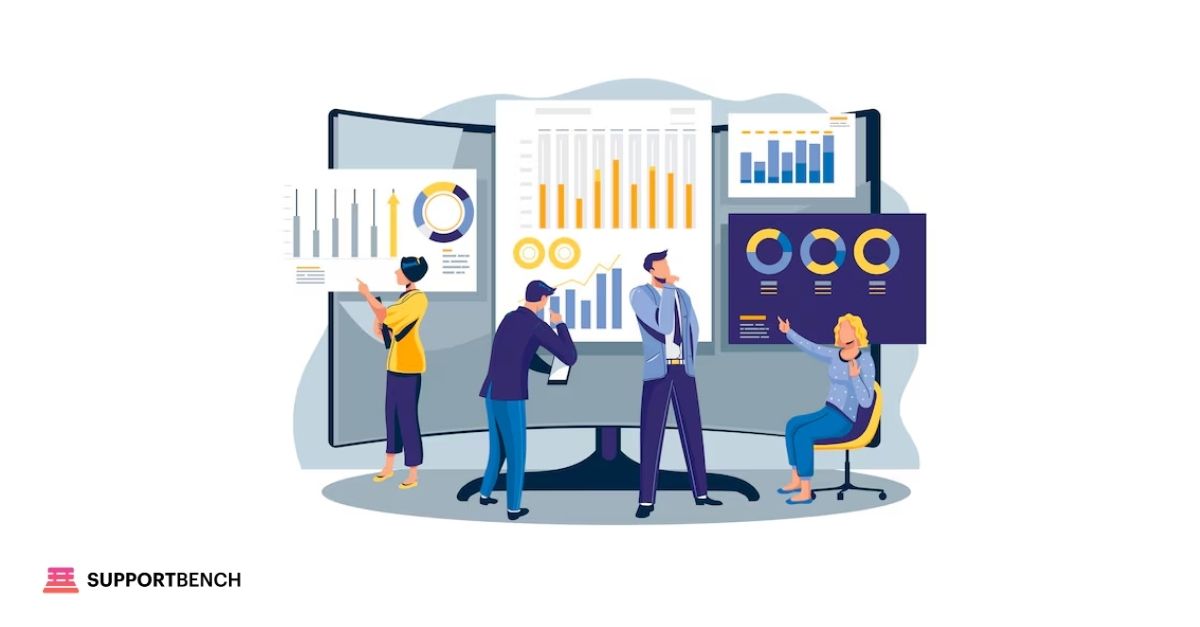
Business development requires a versatile skill set that blends strategic thinking with interpersonal communication. Whether you’re managing partnerships or analyzing new markets, these capabilities are essential.
1. Communication and Interpersonal Skills
Clear communication—both written and verbal—is critical. You’ll need to explain ideas, pitch value propositions, and navigate complex conversations with clients, partners, and internal teams.
2. Strategic Thinking and Planning
Effective business developers think beyond short-term wins. They map opportunities to long-term goals, anticipate challenges, and help shape growth roadmaps across departments.
3. Market Research and Analytical Abilities
You’ll often need to assess customer needs, study competitors, and spot emerging trends. This requires strong research habits and the ability to interpret data to guide smart decisions.
4. Negotiation and Persuasion
Deals don’t close themselves. You must be able to negotiate terms that align with both company and client priorities—while maintaining trust and momentum throughout the process.
5. Project Management and Organization
Business development touches multiple teams and timelines. Skills in task coordination, time management, and milestone tracking help keep initiatives on track and aligned with goals.
6. Business Ethics and Professionalism
Trust matters. Professionals in this role must maintain confidentiality, respect legal boundaries, and build long-term credibility through integrity and responsible communication.
These skills apply across industries and company sizes. In a startup, they may involve wearing multiple hats. In a large enterprise, they often support cross-functional teams. In either case, the fundamentals remain the same: find opportunities, build value, and help the business grow—sustainably.
Conclusion
Business development is more than a job title—it’s a long-term growth engine that touches every part of an organization. From identifying new market opportunities to nurturing strategic relationships, it connects insight with execution.
The success of any strategy depends not just on vision, but also on having the right support systems in place. This is where platforms like Supportbench can make a measurable impact. With powerful tools for managing customer interactions and generating actionable insights, Supportbench helps you align outreach, operations, and outcomes.
In competitive environments, consistency, data-driven decisions, and meaningful relationships are what set businesses apart. A strong business development foundation enables all three—and positions your company for sustained success.


